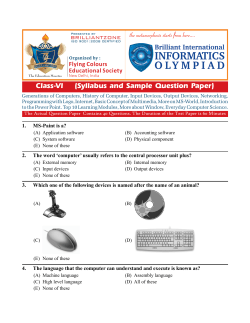
Document 317484
جامعة سلمان بن عبد العزيز كلية الهندسة قسم الهندسة الكهربائية المستوي السادس Salman Bin Abdul Aziz University College of Engineering Department of Electrical Engineering Level 6th Name: ID: EE 3541 Introduction to Microprocessors HomeWork (1) Term1 Academic Year: 1435/1436H-2014/2015G Answer the Following Questions: 1. What are the four building blocks of a microprocessor system? 2. Is the 8088 an 8-bit or a16-bit microprocessor? 3. Mention the address capability of 8086 and also show its memory map. 1-10 4. Describe memory segmentation scheme of 8086. 5. Name the two processing units of the 8088 microprocessor. 6. Which processing unit for the 8088 microprocessor is the interface to the outside world? 7. What are the length of the 8086’s address bus and data bus? 8. List the elements of the execution unit. 2-10 9. What is the purpose of a software model for a microprocessor? 10. How many registers are located within the 8088 microprocessor? 11. How large is the 8088’s memory address space? 12. Is the memory in the 8088 microprocessor organized as byte, word or doubleword? 13. Which of the 8088’s internal registers are used for memory segmentation? 3-10 14. What register defines the beginning of the current code segment in memory? 15. What is the function of the instruction pointer register? 16. What happens to the value in IP each time 8088 microprocessor completes an instruction 17. Make a list of the general purpose registers? 4-10 19. What kind of information is stored in the pointer and index registers? 20. Name the two pointer registers 21. What do SI and DI stand for? 22. What is the difference between SI and DI? 5-10 23. Describe the function of each status flag. 24. What does TF stand for? 25. What is the word length of the 8088’s physical address? 26. What two address elements are combined to form physical address? 6-10 27. Discuss logical address, base segment address and physical address. 28. Describe how the 20-bit physical address is generated. 29. The carry flag bit is set by what arithmetic operations? 30. Calculate the value of each of the physical addresses that follows. Assume all numbers are hexadecimal numbers. (a) 1000:1234 (b) 0100:ABCD (c) A200:12CF (d) B2C0:FA12 7-10 31. Find the unknown value for each of the following physical address. Assume all numbers are hexadecimal numbers. (a) A000:? =A0123 (b) ?:14DA=235DA (c) D765:? =DABC0 (d) ?:CD21=32D21 32. Find the memory address of the next instruction executed by the microprocessor, when operated in the real mode, for the following CS:IP combinations: (a) CS = 1000H and IP = 2000H (b) CS = 2000H and IP = 1000H (c) CS = 2300H and IP = 1A00H (d) CS =1A00H and IP = B000H (e) CS = 3456H and IP = ABCDH 8-10 33. The stack memory is addressed by a combination of the ________ segment plus ________ offset. 34. If the base pointer (BP) addresses memory, the ________ segment contains the data. 35. What is the function of the stack? 36. Determine the memory location addressed by the following 8086/8088 register combinations: 9-10 (a) DS =1000H and DI =2000H (b) DS = 2000H and SI = 1002H (c) SS = 2300H and BP =3200H (d) DS =A000H and BX =1000H (e) SS =2900H and SP = 3A00H 10-10
© Copyright 2025















